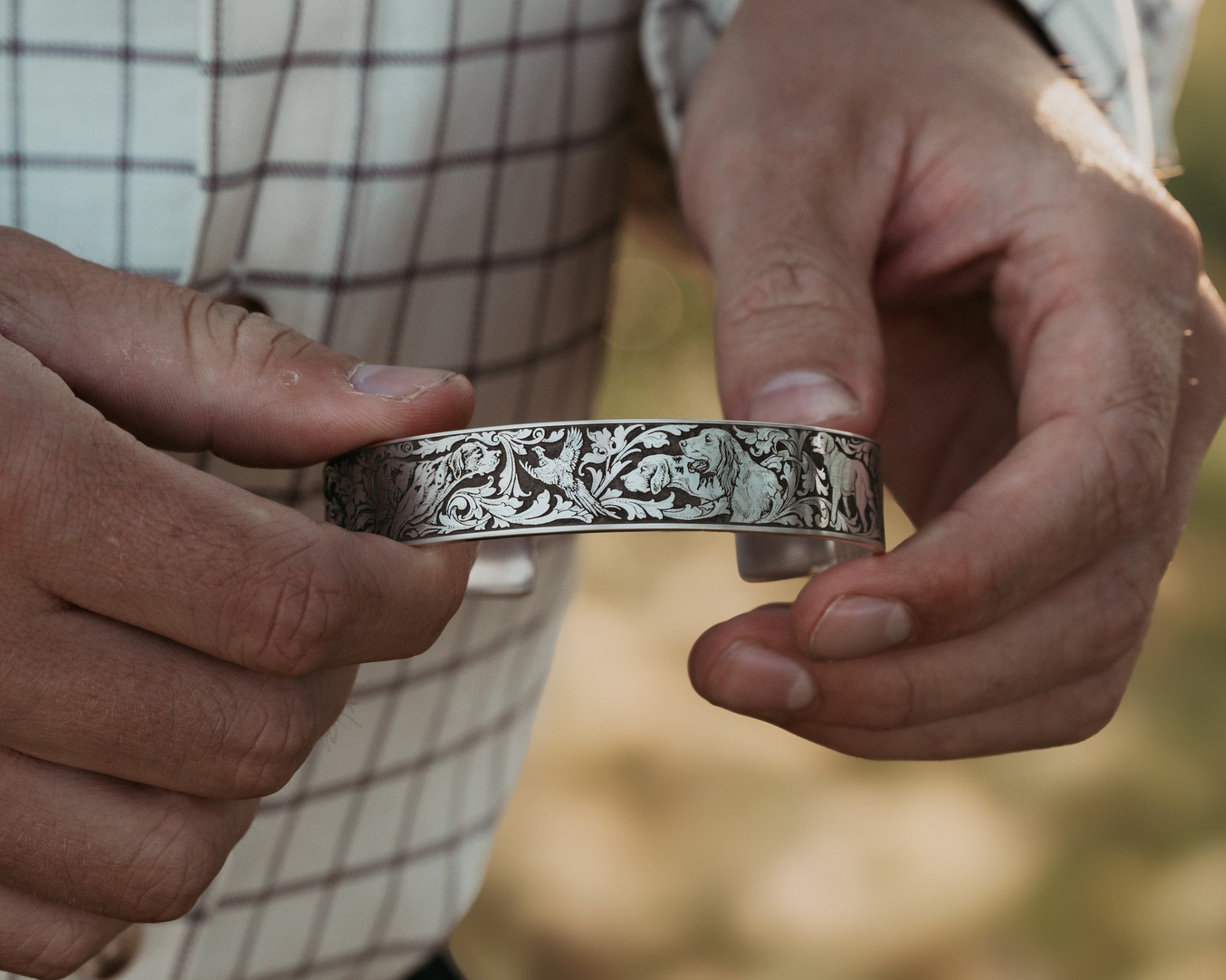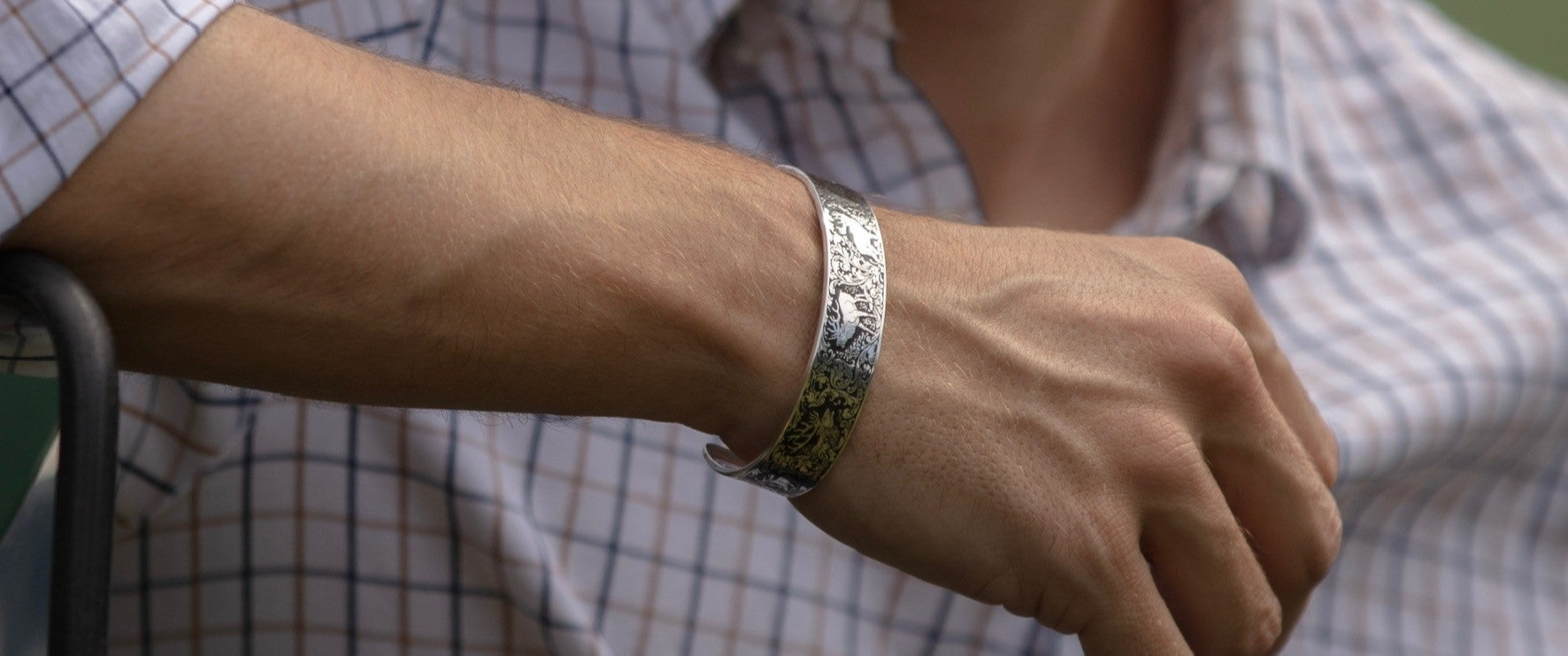
The Craft Behind a Handmade Bracelet, Part 3 | Ken Hunt
Read Part 2: The metal and the marks
Why we still do it the slow way
If speed were the metric, none of this makes sense. Hand sanding for forty minutes when a tumbler could do a passable job; forming on wood and nylon when a hydraulic press could crank out ovals; applying ink in five thin coats when one thick one would look dark enough under bright lights. We do it the slow way for three reasons.
First, longevity
Deep cuts and careful finishing mean the bracelet can be refreshed in ten years without losing its character. Surface scratches polish out; edges remain crisp; the art stays proud.
Second, legibility
Ken’s designs are busy in the best sense, alive with line. The wrong polish rounds those lines; the wrong ink pools where it shouldn’t; the wrong curve makes the art fight the light. Doing it properly keeps the pattern readable at a glance and rewarding up close.
Third, honesty
The bracelet should tell the truth about what it is. You can feel hand-formed metal. You can see a line that has been cut rather than printed. You can run a fingertip over the background and feel the slight bite where ink sits. Honesty is a luxury in itself.
Traditional technique, modern fidelity
Some will ask why we use a laser at all. The short answer is fidelity and access. The laser lets us carry Ken’s voice into more wrists without diluting it, provided we respect what the beam is good at and design for it. We are not replacing hand skill; we are extending it. When you see the laser work next to a hand-cut piece, you’ll spot the differences, the chamfer sparkle of the hand tool versus the crisp wall of the beam, and you might simply prefer one over the other. Both meet the same bar for depth, clarity and finish. Both are made slowly and finished by hand. Both exist because Ken drew something worth carrying.
The hours in the metal
Ken used to say that part of the value of a gun was that you could see the hours in it. That idea survived the journey from cabinet to wrist. A typical bracelet carries hours of human attention before it meets yours: drawing, proofing, cutting, sanding, polishing, forming, polishing again, inking in layers, personalising, checking, boxing. Some of those hours happen late in the evening, when distractions fall away and the work finds its own pace. That’s not romance; it’s a practical truth about focus. Many of our best passes are made between ten at night and three in the morning, the same window Ken favoured at his bench.
Made, not manufactured
The language around craft is crowded with clichés, so let’s keep it simple. A Ken Hunt bracelet is:
- Drawn by Ken Hunt at large scale on paper to hold life when reduced.
- Metal Cut by Charlie, Ken's grandson.
- Formed by hand by Charlie on wood and nylon to the shape a wrist actually wants.
- Sanded and polished by hand by Charlie, twice, for surface and for edge.
- Contrasted by Charlie with patient, layered inking so the relief reads cleanly.
- Marked with the KCH hallmark so you know whose work it is.
That is what we mean by “made”.
Why it matters to us
There’s a final point to make, and it’s not about technique. For three generations our family’s engraving has lived, mainly, on objects that many people will never hold: London Best guns made for a small circle of owners, often kept out of sight. Jewellery changes that. It lets the art travel, to dinner, to an airport lounge, to a day in town, and it invites questions and conversations. It’s field art you can wear, made slowly, with the same standards that governed the work in the gunroom.
Perfection doesn’t exist. We know that. But getting closer is a worthy goal, and on a good day you’ll catch the bracelet in raking light and see a line, or a leaf, or a shadow that feels exactly right. If you can see the hours in the metal, we’ve done our job.


Leave a comment
This site is protected by hCaptcha and the hCaptcha Privacy Policy and Terms of Service apply.